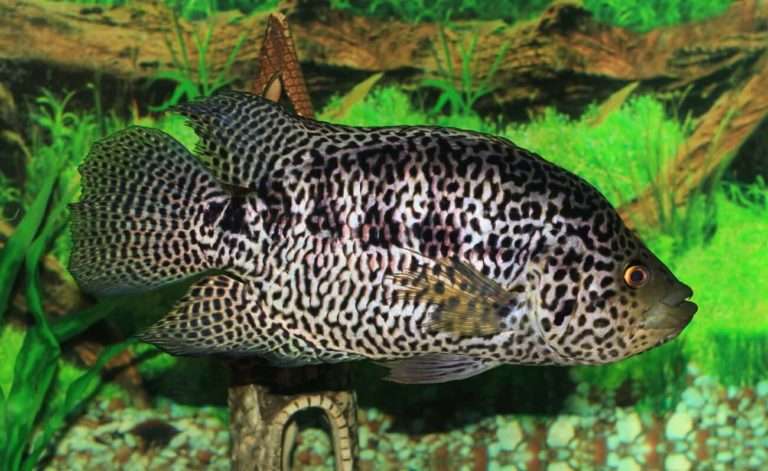
Size
14 inches
Physical Characteristics and Behavior
The jaguar cichlid must be among the most attractive freshwater fish, despite not being as showy as some of the other exotic fish on our list. Like a jaguar, it has a huge, elongated, ovoid body covered in various-sized black and brown spots. A jaguar cichlid has big, flamboyant dorsal and anal fins that are supported by slender rays. The odd look of this fish, which includes a large mouth and a protruding lower jaw with exposed teeth, makes it one of the most fascinating fishes.
Keeping as Pet

- Care of Aquariums
As long as their water is maintained clean, the Jaguar Cichlid are rather simple to manage for, however they probably need simple or large canister filters to fully clean it. Since they are closed systems, all aquariums require maintenance. In home aquariums, phosphates and nitrates accumulate over time, and evaporation causes the water’s hardness to rise. At least 20 to 30 percent of the tank’s water needs to be changed every two weeks because these fish are extremely sensitive to contaminants and pH instability, especially if the tank is well filled. Always use a gravel cleaner while doing water changes to ensure that all of the organic waste that has accumulated from decomposition is eliminated. Decomposing organic debris is typically the root of the bulk of issues that arise in tropical fish tanks.
Water Changes: Every two weeks
- Setup of an aquarium
The tank for the Jaguar Cichlid must be at least 125 gallons. If you intend to keep additional fish, you’ll need a sizable tank with well marked territorial boundaries and a place for hiding because these fish are extremely aggressive. Huge boulders, caverns, and driftwood should be used as part of the decor, and a substrate consisting of large gravel should also be used.
There is no need to put plants because these big fish would probably rapidly eat them! To recreate the murky, muddy environment that the Jaguar Cichlids fish are native to, place a bag of aquarium-safe peat and a couple handfuls of dried leaves in the filter. Every few weeks, the leaves will need to be replaced. They require strong and effective filtration in addition to good water flow. Since these fish can seriously harm internal heaters and filters, it is advised to utilise external tank equipment. A sump-style filter that has heaters inside the sump performs excellently and saves money on replacing the equipment.
- 125 gal. minimum tank size (473 L)
- Type of Substrate: Small Gravel
- Temperature: 75.0 to 82.0° F (23.9 to 27.8° C)
- Illumination requirements: moderate to standard lighting
- 82.0° F is Breeding Temperature
- pH: 7.0 to 8.7
- Range of Hardness: 10 to 15 dGH
- Moderate water movement
- All Water Regions
- Feeding
The Jaguar Cichlid is a carnivore, a predator that consumes larger invertebrates and smaller fish in its natural habitat. They will enthusiastically consume huge live items in the aquarium, including tadpoles, earthworms, crickets, and other insects as well as goldfish and other tiny fish.
Although several kinds of live fish are their preferred meal, they will also eat large chunks of food like cut-up fish and crayfish, as well as freeze-dried and dry foods. In addition to the recommended daily feeding, several experts now advise once a week fasting for your fish.
- Water Parameters
A 100-gallon tank with a pH range of 5.0 to 7.2 and a temperature range of 24 to 28 degrees Celsius is necessary for the Jaguar cichlid. A water hardness of 10 to 15 dGH is also involved.
Table





